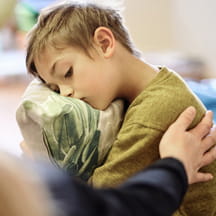In the face of COVID-19, children's hospitals took agility to new heights—instantly thinking and working in new ways out of necessity. It didn't take long for changes to start driving efficiencies, improving experiences for staff, patients and families and enhancing care. That's why many adjustments the pandemic has brought to children's hospitals will be here to stay even in a post-COVID world.
In the summer issue of Children's Hospitals Today, we'll take a closer look at eight ways children's hospitals are improving outcomes—now and into the future—with innovations born out of the pandemic response. Here's a sneak peek into those glimmers of hope: how one children's hospital is improving quality and safety for its staff members.
Security, visitation policies take hold
Among the first responses to the initial spread of COVID-19 for many health care facilities was to shore up security. At Children's Hospital at Erlanger in Chattanooga, Tennessee, entry points are limited and everyone entering the building is required to wear a mask and be screened before gaining access to the facility.
While these measures are necessary during a pandemic, they may last long after COVID-19 is gone. "It's probably a good best practice. It's expensive because you have to pay people to sit at the door, but you have to think about the long-term benefits," says Don Mueller, M.D., former CEO, Children's Hospital at Erlanger. "Maybe you do it during certain times of the year, which would make sense. Influenza season would be a great time to institute it."
The hospital has taken additional steps to protect staff, patients and their families by tightening its visitation policy; Mueller says limiting visitors can provide benefits for health care workers and the patients in their care. "It's a balance because you need to be compassionate, but at the same time it can get blown out of proportion and become a logistical nightmare," Mueller says. "I've been in delivery rooms (before the pandemic) where there are a dozen people there while a woman is trying to have a baby."
Giving gifts of money, time
Erlanger has also established two charitable programs enabling staffers to receive much-needed assistance from the community—and each other:
- PTO donations. Staff members from across the organization can donate unused paid time off to nurses and other front-line employees who may not have any PTO available. "It's good financially for the organization, but it also helps people help each other," Mueller says.
- Employee Assistance Fund. COVID-19 has dealt families across the country a devastating financial blow, but that problem was exacerbated for many in the Chattanooga area when a powerful tornado ripped through the region in mid-April. "I believe we had 34 employees either lose their homes or suffer significant property losses in the tornado," Mueller says. "We set up an Employee Assistance Fund where employees—as well as people from the outside—can donate money.
The summer issue of Children' Hospitals Today, including "Glimmers of Hope: Emerging Bright Spots from the COVID-19 Pandemic," arrives on the CHA website and in your mailbox later this month.


